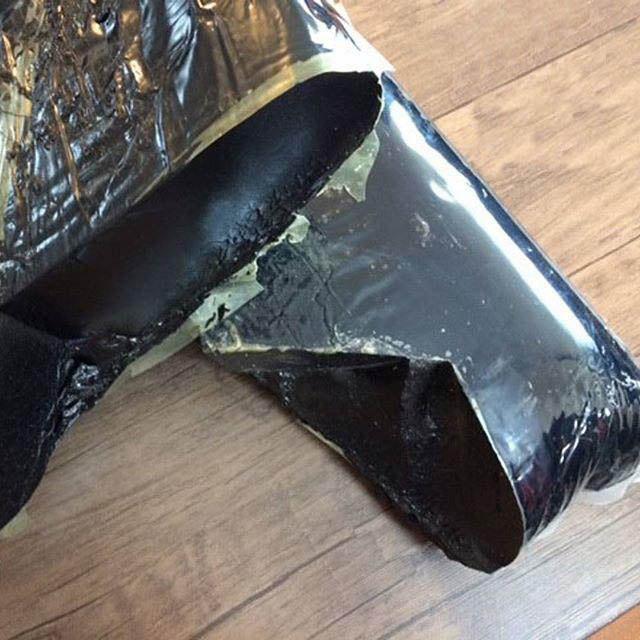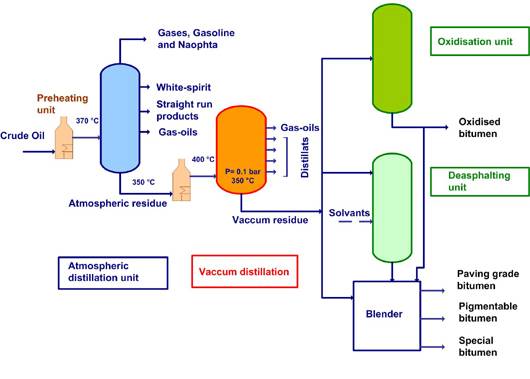
Blown asphalt

Iran Blown Asphalt Supplier and Exporter
General description of blown asphalt
The properties of asphalt can be modified by air blowing in batch and continuous processes. Blown asphalt has more and stronger molecular interactions than the original bitumen and is, therefore, more cohesive. Blowing causes the softening point to increase and the penetration to decrease. However, the increase in softening point is usually more than the decrease in penetration. This means that blowing reduces the temperature susceptibility of bitumen. The effectiveness of blowing depends largely on the original bitumen (i.e. the original mixture of molecular structures).
The regular distillation process is discontinued at some point while the topped crude is still liquid. The heavy fraction is then put into a converter and air is blown through it while it is maintained at a high temperature. This process is continued until the asphalt has attained desired properties. Often, such asphalts are called Blown asphalt. However, this is not strictly a true term because not only oxidation but also vaporization, Dehydrogenation, condensation, polymerization and other reactions occur during the air blowing process.

Blown asphalt comes from hot air blown to pure bitumen in the last stage of refining. In this process, hot air having 200-300 degree centigrade temperature is blown to bitumen container with porous tubes. In this process, hydrogen atoms in bitumen hydrocarbon are combined with oxygen in the air and by forming water, polymerization happens. Compared with pure bitumen, blown bitumen has a low penetration rate and a high softness point. Blown asphalt grades or Oxidized bitumen are produced by passing air through the penetration grades. This process gives the bitumen more rubbery properties than its original formula and they are simply harder bitumen. Hard bitumen under controlled temperature conditions is widely used as an anti-slip layer compound in the piling industry, for the manufacture of roofing felts, the roofing and waterproofing industries, for sound dampening, felts and under carriage sealant in the automotive industry, electric cable joint protection, joint filling compound, sealant compound and many others. Also used in sealing saw cuts and joints where expected movements are minimum. It is also used in the manufacturing of bituminous marine mastic for the oil & gas pipeline joints. The most popular grades are; grades 95/25, 85/25, 90/40, and 115/15. We are also capable of producing other grades of blown Bitumen upon request by our customers. Oxidized Bitumen high softening temperatures qualify them as an excellent sealant for prevention from bleeding in high-temperature applications. Blown Grade asphalt shall be broken up into small pieces (for the blown grade in molded cake form) and heated slowly to the application temperature of 220ºC to 230ºC. Blown Bitumen is predominantly used in the piling industry as an anti-slip compound for the manufacture of undercarriage sealants in the automobile industry. It is also used as a sealant compound, as a joint filling compound apart from being used in the manufacture of roofing felts and sound dampening felts. Further, Blown asphalt is used in the manufacture of bituminous marine mastic, which is required for the oil and gas pipeline joints. This blown asphalt is available in different grades like 95/25, 85/25, 75/25, 90/40 and 115/15. Other grades of blown asphalt are produced according to the specifications of individual clients. Some of the major advantages of blown asphalt are that it is completely water resistant, highly flexible and durable. Further, it is chemically very stable. Blown asphalt is a very flexible compound that is not only chemically stable but also a very durable compound apart from being completely water resistant. Lastly, blown asphalt has some very prominent technical advantages that make it a very sought after compound in various applications.
Application of blown asphalt
- As a bonding bitumen for roofing sheet membranes.
- For rust proof pipe coatings.
- As a hot-applied waterproofing layer.
- As a raw material for liquid bitumen coatings.
- Used as an anti-slip layer compound in the piling industry.
- For the production of bituminous paints, mastic.
- Used for production of roofing and sound dampening felts, Used as under carriage sealant in the automobile industry electric cable joint protection, joint filling compound, sealant compound and much more in our day to day life.
- Oxidized Bitumen has a wide variety of industrial applications.
Properties of bitumens used in roofing
Because bitumen is used in a number of roofing products and systems calling for different physical properties, both straight-run bitumens, and blown asphalt processed to a range of viscosities, are used in roofing. Historically, both straight run and oxidized bitumens have been manufactured by petroleum refineries, and this remains largely true in Europe today.
A separate description of the global bitumen manufacturing industry describes North American and European bitumen manufacturing processes, and the chemistry and physical properties of straight run and oxidized bitumens, from the refiner’s perspective. In North America, most oxidized bitumen is produced downstream of refineries, by roofing product manufacturers and other bitumen processors who acquire straight-run bitumen from refineries for use as feedstocks for oxidation operations. Chemistry of Air Blowing Oxidation, or air blowing, is the process of passing air through heated bitumen to raise the softening point/viscosity of the bitumen while maintaining much of its flexibility at lower temperatures. The use of this process dates from the late 19th century and it is used to make a wide variety of products with markedly different softening points depending on the extent of oxidation used.
On one end of this continuum are very slightly blown asphalt used for felt saturant and modified bitumen membranes, which are oxidized to softening points below 50°C, in the range of air rectified bitumens. The hardest bitumens typically used in roofing products BUR products meeting North American specifications for Types III and IV, and shingle coatings are oxidized to softening points of roughly 100°C.These products, however, actually lie at an intermediate point on the continuum of bitumen oxidation. At the upper end of the range are tired processing aids and drilling mud additives oxidized to softening points around 150°C. It is difficult to achieve softening points higher than this with commercial oxidation equipment operated at standard temperatures.
Blown asphalt production process
Bitumen is a hydrocarbon product which is received as the distillation bottom product of an oil refining process and has a high boiling point and viscosity and is soluble in trichloroethylene. Also, the soluble binder product separated from natural asphalts by extraction is bitumen. To improve the properties of bitumen it can be oxidated to be suitable for intended applications. This oxidation can be carried out by leading air to the bitumen which is oxidated by the effect of the oxygen diffused into the oil phase from the air.
In modern preparation methods of oxidated (blown or semi-blown), asphalt qualities the air needed for the oxidation and the bitumen oil is brought into contact in a large volume reactor (so-called bubble column technique). The drawbacks of the method are the safety risks because of the large oil and gas volume, the high oxygen content of the rest gas, a bad adjustability of the reaction and the reduced quality properties of the product because of the long retention time.
The contact between the bitumen and the oxygen has been improved by using a turbine mixer in the oxidation of the asphalt. This turbine mixer comprises a mixer foreseen with an impeller that consists of a cogged face plate. The use of such a mixer does not, however, essentially improve the transfer of the material.
It is also mentioned as prior art which is concerned with a method of oxidation of asphalt by air in a large volume reactor. The aim of this invention is to reduce the retention time of the oxidation reaction and thus avoid reducing the quality properties. The cold properties are even improved. The aim is e.g. to achieve a bitumen product suitable to be used as road coating expressly in cold conditions, as in the Northern countries, which for instance means that no fractures are allowed to be formed into the coating.
The method of the invention is mainly characterized in that the oxidation is carried out by leading a supply stream of bitumen or the like and an air stream or another pressurized gaseous oxidant to a reactor which is a so-called rotating apparatus and in which reactor the contact between the air or other gaseous oxidant and the bitumen or the like is improved by generating turbulence by mixing devices of rotor-stator type that generate shear forces to achieve a good mixing.
The advantageous embodiments of the invention have the characteristics of the sub-claims.
The contact between the air and the bitumen is carried out in the invention by using high turbulence. The reactor used in the invention generates turbulence by using mixing devices of rotor-stator type that generate the shear forces: the bitumen and the air are forced through the reactor in such a way that strong shear forces and much mixing are directed to those with a good dispersion of the air as a result that is very advantageous for the contact. In the preparation method of the invention, the reactor used to improve the contact of the air-bitumen mixture, the so-called rotating apparatus, is a so-called power homogenizer, which is a mixing device of the type wherein the mixing is achieved ¦ by one or more rotor-stator pairs, alone or in series.
Production process:
- Bitumen heating to 265-270 °C
- Transferring melted bitumen to blowing towers
- Blowing air to bitumen
- Cooling melted bitumen with water
- Packing
The procedures of producing bitumen are as follows:
- Continuous blowing procedure
- Discontinuous blowing procedure
These two procedures are done by other two procedures named catalysis and anti-catalysis.
Catalysis means adding some chemical material during the process In order to decrease blowing reaction time.
For the following reasons:
- Ease and simplicity in changing blowing condition and have a production with different grades as a result.
- Ease in generating the unit.
- Ease in technology and also low expense in investment. The discontinuous producing procedure is chosen.
The production process is as follows:
The producing operation of oxidized bitumen mainly includes tank loading different steps, bitumen blowing, condenser external gasses and packing. So, in the beginning, the loose bitumen shipped to the plant by tanker is transferred to the raw material store tanker. In order to transfer the bitumen easily to the blowing tower, the burner is contrived at the bottom of the store tanker to heat them. It is necessary to say that if the blowing towers are empty, hot bitumen can be uploaded directly to them and blowing operation start. Since the volume of bitumen increases as a result of blowing and it may overflow, the blowing the tower is filled up to 70 %. Air injection is usually done when the temperature of material reach to 190-230 °C. For gradual heating and also pipes filling with the air is entered from the top of the tower and at the bottom, the bitumen dispread monotonously in phase via nozzles then oxidation is done accordingly and the light molecule, volatile gasses, and steam are emitted from the top of the tower. Blowing operation is done in the temperature range 215-290°C but the suitable temperature is between 265 to 270°C. The needed heat is provided by burner contrived at the bottom of the tower. The bitumen reaction is calorific so in order to prevent the explosion danger resulted from temperature increasing, the temperature can be controlled by water injection, burner extinguisher and air amount reducing.The blowing end point is usually signified by sampling from tower and bitumen properties testing. The blowing operation stops when blown asphalt reaches to specified properties. After this in order to fix the final point and depolymerization bitumen got in high temperature. It is necessary to be transferred to store after packing and presented to sale. It is necessary to say that the produced gas and steam entered the condenser through the pipe fixed at the top of the blowing tower. In this stage, the bad smelling gasses and oily and volatile parts are separated from then transfer to sewage accompanied with water. Others separated gas parts are emitted from the top of the condenser then transfer to the furnace and burned there. After cooling the blowing oven and reaching them to 150-160°C, all the content of blowing oven which is hard bitumen is able to be loaded and packed. Because of the liquid height in blowing tower, oxidized bitumen is transferred by specific gravity and there is no need to use the pump. Packing is done in two sections and in drum and 25kg carton. For fast operation (preventing from cooling & hardening) in every section, several taps are fixed so that it can fill specific drum and carton with bitumen at the same time.
Oxidized bitumen testing standard
- Analysis of commercial bulk cargoes to ASTM, ISO, EN and similar specifications
- Analysis of the basic performance characteristics such as:
- Penetration numbers
- Needle penetration
- Cone penetration
- Hardness
- Ductility
- Melting point
- Density
- Storage monitoring to assess oxidation state
- Testing of drummed bitumen over time to assess’ batch lifetime.
| NO | Reference and standard number | Specification of test |
| 1 | EN 1426 | NEEDLE PENETRATION |
| 2 | EN 1427 | SOFTENING POINT |
| 3 | EN 12592 | SOLUBILITY |
| 4 | EN 12593 | FRAASS BREAKING POINT |
| 5 | EN 12595 | KINEMATIC VISCOSITY |
| 6 | EN 12596 | DYNAMIC VISCOSITY BY VACUUM CAPILLARY |
| 7 | EN 12607-1 | RESISTANCE TO HARDENING UNDER INFLUENCE OF HEAT AND AIR PART1: RTFOT |
| 8 | EN 22592 | FLASH AND FIRE POINT- CLEVELAND OPEN CUP |
| 9 | EN 12719 | FLASH POINT-PENSKY- MARTENS CLSED CUP |
| 10 | EN ISO 3838 | DENSITY OR RELATIVE DENSITY –CAPILLARY PYKNOMETER |
| 11 | EN 13301 | STAINING TENDENCY OF BITUMEN |
| 12 | EN 13302 | VISCOSITY OF BITUMEN USING A ROTATING SPINDLE APPARATUS |
| 13 | EN 13303 | LOSS IN MASS AFTER HEATING OF INDUSTRIAL BITUMEN |
| 14 | EN 13398 | ELASTIC RECOVERY OF MODIFIED BITUMEN |
| 15 | EN 13399 | STORAGE STABILITY OF MODIFIED BITUMEN |
| 16 | EN 13587 | TENSILE PROPERTIES OF BITUMINOUS BINDERS BY THE TENSILE METHOD |
| 17 | EN 13588 | COHESION OF BITUMINOUS BINDERS WITH PENDULUM TEST |
| 18 | EN 13589 | TENSILE PROPERTIES OF MODIFIED BITUMEN BY THE FORCE DUCTILITY METHOD |
| 19 | EN 13702-1 | MODIFIED BITUMEN PART1: CONE AND PLATE METHOD |
| 20 | EN 13702-2 | MODIFIED BITUMEN PART2: COAXIAL CYLINDERS METHOD |
| 21 | EN 13703 | DEFORMATION ENERGY |
| 22 | EN 58 | BITUMEN SAMPLING |
| 23 | EN 12594 | PREPARATION OF TEST SAMPLES |
